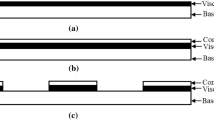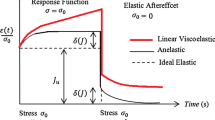Abstract
Our experimental investigations are focused on evaluating the elastodynamic response characteristics of a beam fabricated in an electrorheological fluid when the beam is subjected to forced vibration. The beam which is designed in this experiment is composed of three kinds of materials, i.e. structural material, damping material and sealant material. Different ratios of structural material to damping material have been tested in an applied electric field. The results demonstrate clearly the ability to significantly change the vibrational characteristics of a beam fabricated in a smart composite by changing the electric field intensity imposed on the fluid domains. The ASTM standard E756-83 equations are used to evaluate the Young's modulus of the beam.
Similar content being viewed by others
References
Gandhi, M. V. and Thompson, B. S., inSmart Materials and Structures, Chapman and Hall, London, 1992, pp. 70–88.
Du, S. Y. and Leng, J. S.,Advances in Mechanics 4, 1992, 496.
Du, S. Y. and Leng, J. S.,Aerospace Materials and Technology 5, 1992, 14.
Choi, Y., Sprecher, A. F., and Conard, H.,J. Intel. Mat. Syst. and Struc. 1(1), 1990, 91.
ASTM Standard E756-83, The American Society for Testing of Materials.
Author information
Authors and Affiliations
Rights and permissions
About this article
Cite this article
Leng, J.S., Liu, Y.J., Du, S.Y. et al. Active vibration control of smart composites featuring electro-rheological fluids. Appl Compos Mater 2, 59–65 (1995). https://doi.org/10.1007/BF00567378
Received:
Accepted:
Issue Date:
DOI: https://doi.org/10.1007/BF00567378




